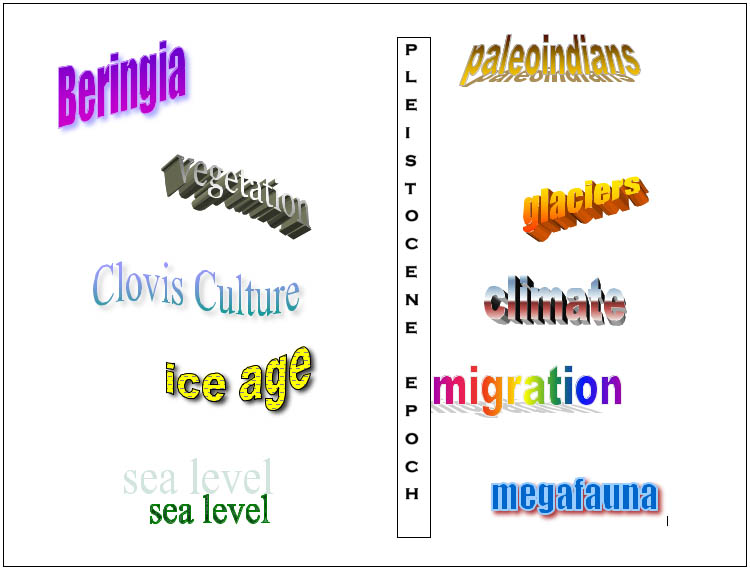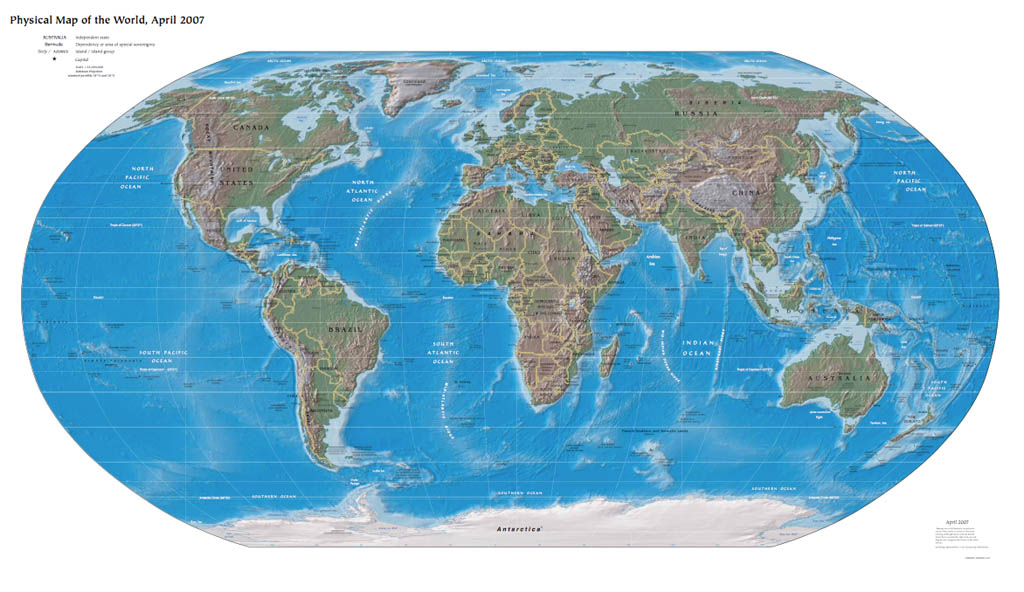These activities, designed to accompany First Peoples and The Mystery of the First Americans, will enable students to explore the origins of human populations in North America. The activities may be used independently of each other or together.
Preview activity
This activity is designed to be used before students read "First Peoples" and "The Mystery of the First Americans." A more detailed version of the activity, "Theories of Migration," includes a chart for students to fill in information about the various theories as they read.
- Project or put up a modern world map. (If you don't have a map in your classroom, you may want to use the map below. Click on the "about the map" link below the image for a larger version.)
- Explain that people did not originate in North and South America.
- Ask the question, ?How did the first people get to the Americas??
- Allow the students several minutes to think about this question while examining the map. You may also have the students discuss these in cooperative pairs.
- Take brainstorming ideas from the students and record them on chart paper.
- You can refer to this throughout the class' work with First Peoples and The Mystery of the First Americans.
- You will most likely find that many of the students have heard of the Beringia migration theory, but that they will not have heard of the more recent discoveries that are leading to new theories.
Wordsplash activity: Pleistocene vocabulary
Advance preparation
Be familiar with the use of wordsplash as a pre-reading activity.
Procedure
- Design a wordsplash with the topic "Pleistocene epoch" in the center. Around the central topic include the following: Beringia, ice age, paleoindians, vegetation, migration, climate, Clovis culture, sea level, glacier, and megafauna. You may include other vocabulary from First Peoples. To see a larger version of the sample wordsplash below, click on the "about the illustration" link below the image.
- Introduce the Pleistocene epoch. (The Pleistocene epoch was the time of the last great ice age. It lasted from 2 million to 8000 BCE -- before the common era.)
- You may choose to have the students predict how the words are related to the Pleistocene. Have them choose four or five of the words as a bellringer and write a sentence expressing the relationship between the topic and the words.
- Another use for the wordsplash is to have the students write a sentence for each word which includes its relationship to the topic as they read the article "First Peoples." For example, "During the Pleistocene epoch, the sea level was lower due to the amount of water that became ice."

Sample Pleistocene wordsplash.
Intrigue of the Past lesson
The lesson Shifting Coastlines, from the UNC Research Laboratories of Archaeology, can be used in conjunction with reading First Peoples. Have the students read and discuss the article before you introduce the lesson.
Writing suggestions for "First Peoples"
- Have students write a paragraph (or short essay) describing how the Native Americans may have arrived in what is now North Carolina. Instruct them to use specific examples from the reading First Peoples.
- Have students write a scene for a movie from the point of view of a migrant traveling through Beringia about 13,000 years ago. What would it have been like at that time? What would be the reason (motive) your character was traveling? Alternatively, students could write a movie plot summary.
- Have the students fill in a graphic organizer that lists the causes of the migration of animals and people, and the effects of that migration.
Writing suggestions for "The Mystery of the First Americans"
- Have the students take on the role of a scientist investigating one of the theories they have read about in The Mystery of the First Americans. Ask them to give the reasons they support or refute that theory.
- Have students write a compare/contrast essay about the similarities and differences between early migrants to the Americas theorized to have come into the interior of the continent by an opening in the ice corridor and those theorized to have come by boat along the western coastline. In the essay, students should address shelter, food, climate, and travel.
Extra credit / group activities
- Assign groups, academically gifted students, or those who would like extra credit to read one of the articles in the right sidebars of both "First Peoples" and "The Mystery of the First Americans." Have them share their readings with the rest of the class the next day, relating the most important ideas. Some of the articles are more difficult than others. Generally from easiest to most difficult: "Microbe's Map of Migration," and "Paleoindians and the Great Pleistocene Die-Off."
- Have groups take on the role of scientists. Choose three or four of the more detailed theories (Clovis, coastal migrations, Kennewick Man, and Monte Verde). Have the students read their notes from the theories chart from the Theories of Migration lesson and the appropriate articles in the right sidebars of "First Peoples" and "The Mystery of the First Americans." You may also ask the groups to do some research on their own. In class, set up a debate between the ?scientists? in your class around the question ?How did the first people come to the Americas?? Have each group of students support their own theory with details from the articles and their research.
